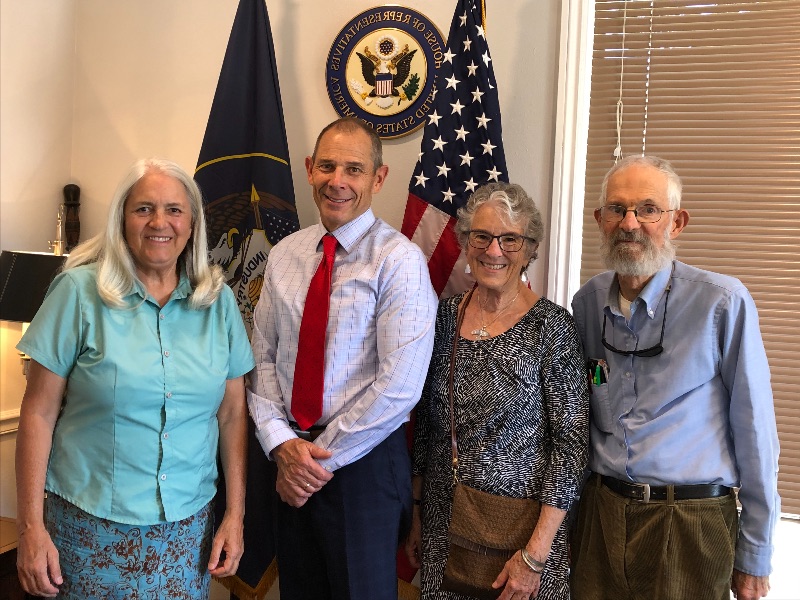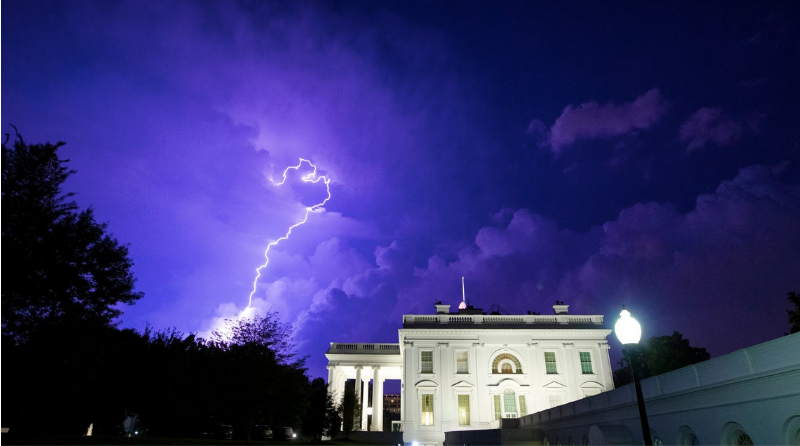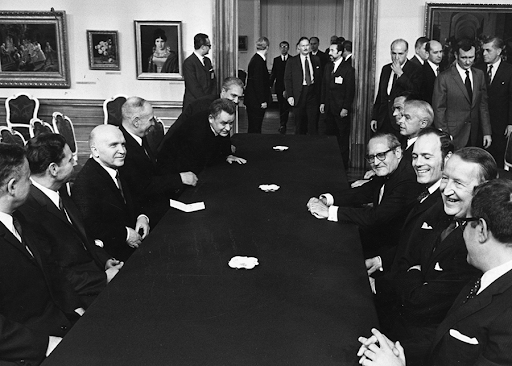It’s hurricane season for arms control. In August, the United States withdrew from the landmark 1987 Intermediate-Range Nuclear Forces (INF) Treaty that had eliminated 2,692 nuclear-armed missiles and helped end the Cold War. The demise of the INF opens the door to a new intermediate-range missile race in Europe. In the aftermath, we are pushing key states to pursue new restraints on this very destabilizing class of weapons.
Reports out this month indicate the Trump Administration may be also poised to withdraw from the Open Skies Treaty as soon as the end of October. The treaty has 34 state parties and provides confidence-building transparency on military activities between the United States, Russia, and European countries by allowing aerial imaging through short-notice, unarmed observation flights. The Open Skies Treaty contributes needed stability and improves each participating state’s national security.
Over the past several months, we have raised awareness of the threats to the Open Skies Treaty through articles in Arms Control Today, collaborated with senior statesmen like Secretaries George Shultz and Bill Perry and fmr. Sen. Sam Nunn, worked to build bipartisan support in Congress, and briefed numerous reporters and editors about the value of the Open Skies Treaty. In October, ACA staff or board members were quoted or mentioned in more than 75 news articles or opinion pieces concerning the treaty.
The erosion of these important barriers against uncertainty and renewed nuclear competition make our ongoing campaign to preserve and extend the New Strategic Arms Reduction Treaty (New START)– the only remaining treaty limiting the world’s two largest nuclear arsenals – all the more important.
The Arms Control Association regularly convenes a “Friends of New START” network of more than 50 former U.S. officials and organizations to help strengthen effort to build bipartisan support for extending New START. Through our Deep Cuts Commission project, we continue to liaise with our U.S., German, and Russian colleagues to stimulate creative thinking at the government level. Earlier this month, with support from the Prospect Hill Foundation and our member donations, we also launched a New START collaborative media outreach project to focus more attention and coverage on the decisions ahead on this.
Through Arms Control Today as well as our special “U.S.-Russian Nuclear Arms Control Watch” e-newsletter, we report on key developments and deliver analysis and recommendations to an audience of more than 10,000 readers around the world.
ACA is playing a leading role in making the case for New START. We are leading coordination of efforts to draw attention to the value of the treaty in the media, and with bi-partisan fact-based advocacy, we are urging policymaker support for New START.
We also need your help to protect New START. If you have not already done so, please listen to our last ACA members’ telebriefing on “The Future of New START” to learn more. Then please take just a few minutes to write your members of Congress in support of new bipartisan, bicameral legislation that has been introduced to help save New START and head off unconstrained nuclear arms competition.
Our work depends on your support. Please help now by making a special donation and by getting involved.
Thank you,
 |
 |
| Daryl G. Kimball Executive Director |
Kathy Crandall Robinson Chief Operations Officer |
Translating Research Into Action:
How Our Members Beyond the Beltway Leverage ACA Resources for Civic Engagement
The Arms Control Association’s dedicated members are bringing the Association’s extensive collection of fact-sheets and research reports to life beyond Washington.
Deb Sawyer, an Arms Control Association member from Utah and leader of two grassroots nuclear disarmament organizations in Salt Lake City, uses the Association’s policy white papers and Nuclear Excess report to educate her members of Congress about the dangerous and excessive plan to overhaul the nation’s nuclear arsenal. Deb leads the Utah Campaign to Abolish Nuclear Weapons (UCAN) to organize constituent meetings with their members of Congress on nuclear weapons policy issues. 
Deb tells us that Utah organizers are committed to building relationships with their Republican and Democratic members of Congress even though their legislative record has often not exhibited support for core nuclear disarmament and arms control priorities. When meeting with their Representatives and Senators, Utah organizers have strategically focused on the issue of eliminating the intercontinental ballistic missile (ICBM) system. The ICBM, she notes, is a “launch under attack” weapon perpetuates the risk of nuclear war due to false warnings. Furthermore, Sawyer and her colleagues note that the plan to replace existing ICBMs with a new fleet of missiles comes with an enormous price tag of $150 billion.
The Trump administration’s nuclear weapons recapitalization plan positions Utah, once again, at the frontlines of the nuclear weapons complex. The city of Roy, Utah now plays host to Northrop Grumman’s new facility to build the GBSD missile systems, adding another chapter to the noxious legacy of Utah communities’ exposure to nuclear weapons testing and uranium mining.
Deb, a life-long Utah resident, first became active in nuclear disarmament advocacy when volunteering on State Senator Senator Frances Farley’s 1980 reelection campaign. As a physics graduate student at the University of Utah, Deb lacked a female mentor in the male-dominated physics department and was inspired by Sen. Farley’s leadership in opposing the deployment of the MX-missile system in Utah.
If we are to succeed in building bipartisan support for common-sense nuclear risk reduction weapons policies, the work of local community organizations and leaders like Deb Sawyer is essential.
Board Chair Thomas Countryman: "The Credibility of American Diplomacy Must be Restored"
Announcing Student Internship Opportunities The Arms Control Association is now accepting internship applications for policy and communications positions for spring 2020. Applications are due November 1.
Fifty Years Ago . . . The First Strategic Arms Limitation Talks Began
Fifty years ago, on Nov. 17, 1969, the United States and the Soviet Union launched the first ever Strategic Arms Limitation Talks (SALT) in Helsinki, Finland. The chief American negotiator was Gerard Smith, who had been appointed director of the U.S. Arms Control and Disarmament Agency by then-president Richard Nixon.
Smith’s opening message that day: “The limitation of strategic arms is in the mutual interests of our country and the Soviet Union.”
Negotiated in the midst of severe tensions, the SALT agreement and the Anti-Ballistic Missile (ABM) Treaty were the first restrictions on the superpowers’ massive strategic offensive weapons, as well as on their emerging strategic defensive systems. The SALT agreement and the ABM Treaty slowed the arms race and opened a period of U.S.-Soviet detente that lessened the threat of nuclear war. The negotiations set a standard for future bilateral nuclear arms control treaty negotiations, designed to limit and later reduce the two side’s excessive nuclear stockpiles.
After the treaty was concluded in 1972, Smith left government but continued his work to prevent nuclear catastrophe in part by joining the Board of Directors of the newly-formed Arms Control Association. He served as the Association’s chairman from 1981 to 1992.
We thank those in government and outside government who have, over the years, helped lead us away from nuclear catastrophe and we pledge to preserve and build upon their achievements in the years ahead.
Book Release Board Member Michael Klare's All Hell Breaking Loose: The Pentagon's Perspective on Climate Change
 Professor Michael Klare, secretary for the Arms Control Association board of directors and senior visiting fellow, will release his newest book All Hell Breaking Loose: The Pentagon’s Perspective on Climate Change as a threat to global stability and U.S. national security.
Professor Michael Klare, secretary for the Arms Control Association board of directors and senior visiting fellow, will release his newest book All Hell Breaking Loose: The Pentagon’s Perspective on Climate Change as a threat to global stability and U.S. national security.
Washington, D.C.-area members can join a book reading and signing event with Professor Klare on:
November 14, 7 pm: Scrawl Books, Reston Regional Library, 11911 Freedom Dr., Reston VA
November 15, 7 pm: Solid State Books, 600F H St. NE, Washington, DC
Breaking Loose can be pre-ordered online and will be available for purchase in local bookstores soon.
In Case You Missed It...
-
Director of Disarmament and Threat Reduction Policy Kingston Reif was cited by DefenseNews on upgrades to both nuclear gravity bombs and warheads. “The delay to both the B6-12 and W88 ALT 370 highlights the enormous scope of work already on NNSA’s overburdened plate,” September 4.
-
Board member Greg Thielmann told PenzaNews that the New START agreement “helped stabilize the U.S.-Russian strategic relationship,” September 8.
-
Executive Director Daryl Kimball explains why the Open Skies Treaty has been mutually beneficial to the United States, allies, and even Russia, Business Insider, October 8
-
The New York Times Editorial Board cites the Arms Control Today article on the importance of the Open Skies Treaty. See: “Open Skies Treaty Allowed Eyes Over Russia,” October 10.
-
In an essay in the widely read blog War on the Rocks, Reif and Steve Fetter, Professor in the School of Public Policy, University of Maryland, explain why the plan to rebuild intercontinental ballistic missiles (IBMcs), the least valuable leg of the nuclear triad, is unsustainable, unsafe, and unnecessary. See: “A Cheaper Nuclear Sponge,” October 18.
-
Board Chair Thomas Countryman appears on Voice of America to discuss North Korea denuclearization diplomacy, October 19
-
Reif comments on President Trump’s admission of the presence of U.S. tactical nuclear weapons stationed in Turkey, The Washington Post, October 16.
On Our Calendar
| Oct. 9-10 | Board member Paul Walker presented on the need for increased public education and outreach for the Chemical Weapons Coalition at the G7 Global Partnership Working Group Meeting on non-proliferation and threat reduction, Paris, France. |
| Oct. 24-25 | Board Chair Thomas Countryman attends the United Nations Institute for Disarmament Research (UNIDIR) Advisory Committee meeting on the Middle East Zone, Vienna, Austria. |
| Oct. 30-Nov. 1 | Countryman represents the Association at the conference “The Future of the Nuclear Order,” at McGill University, Montreal, Canada. |
| Nov. 7-9 | Countryman attends the Moscow Nonproliferation Conference, hosted by the Center for Energy and Security Studies, Moscow, Russia. |
| Nov. 12 | Board member Michael Klare’s new book, All Hell Breaking Loose: The Pentagon’s Perspective on Climate Change, is released. |
| Nov. 15 | Meeting of the Arms Control Association Board of Directors, Washington, DC. |
| Nov. 20-24 | Members of the Chemical Weapons Convention Coalition participate in the The Twenty-Fourth Conference of States Parties to the CWC, The Hague, The Netherlands. |


